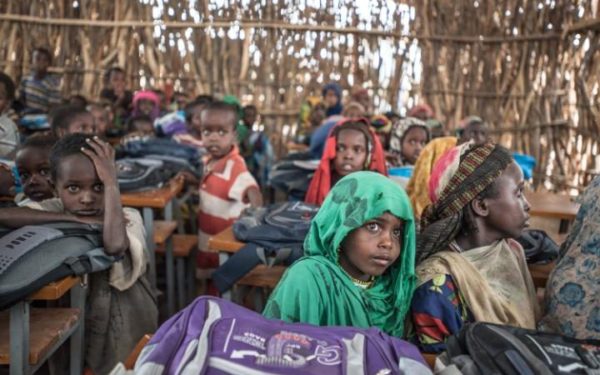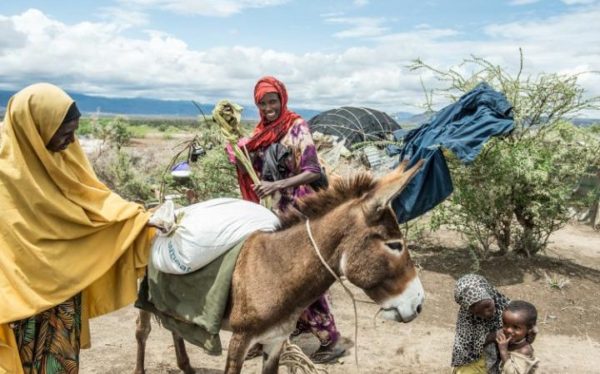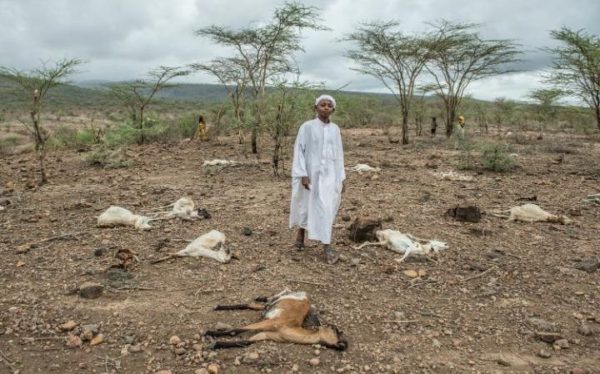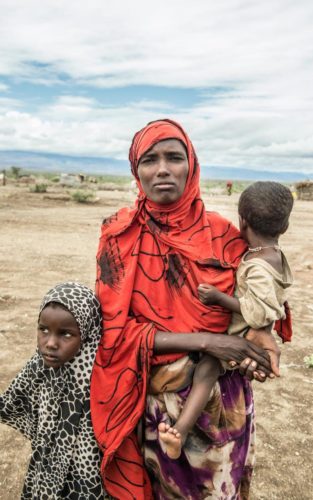PBS: Escaping Eritrea … [Read More...] about ካብ ውሽጢ ቤት ማእሰርታት ኤርትራ
Ethiopia struggles with worst drought for 50 years leaving 18 million people in need of aid
Aislinn Laing, Sitti Zone, Ethiopia |
Every morning Aisha Nor rises at dawn to spend several hours gathering dry twigs from the scrubland around her home. By selling them each week at the local market, she can earn just enough to buy sweet black tea to supplement her children’s daily bread ration. And that, in turn, may be just enough to keep them alive.
With two of her youngsters already dangerously malnourished and the remaining three on the brink, Aisha’s plight is typical of hundreds of thousands of families now facing Ethiopia’s worst drought in 50 years. Two successive rainy seasons have failed, and with no crops to feed either themselves or their cattle, as many as 18 million people are in need of aid.

To Western eyes, the scenes of hunger are disturbingly reminiscent of the country’s infamous famine of 1984, which killed one million people and sparked the Live Aid campaign by the pop singer Bob Geldof.
This time, though, it is not civil war or the callous indifference of a communist regime that is to blame. While the Derg regime of the 1980s used starvation as a weapon, today’s Ethiopian government already runs an annual emergency feeding program for 8 million people.
But in trying to shrug off Ethiopia’s image as the symbol of African famine and disaster, the government has inadvertently courted disaster again. As the early stages of the drought got progressively worse, the authorities refused to admit they could not cope alone, leading to a crucial delay in the international response.
“If the Ethiopian government says they’ve got a massive food crisis, investors pull out, jobs are lost, it becomes self-fulfilling,” said one aid official, who asked not to be named.
The aid worker’s desire for anonymity is yet another symptom of the touchiness that surrounds the aid issue in Ethiopia. Credible statistics about deaths related to the drought are rarely issued, yet humanitarian workers are notably careful about using words such as “famine” or “death”.
This is not just to avoid sensationalism, but because their presence in the country is dependent on not ruffling the feathers of the government, which retains an authoritarian streak.
Mindful of how television cameras portrayed Ethiopia three decades ago, officials also keep a close eye on the foreign media, even tracking down one woman who told a BBC reporter that her child had perished because of the drought. She later appeared on state television, saying her child had died of illness instead.
In its defence, the Ethiopian government points out that the drought in the rural interior is just one strand of its new national narrative. The economy, by contrast, is a relative success story, and has enjoyed several years as one of the fastest growing in the world.

The boom is evident in the cranes dotting the skyline of the capital Addis Ababa, the jean-clad hipsters filling its espresso bars, and the emergence of its national airline as Africa’s preferred low-cost carrier.
But with growth and relative political stability has come a booming population of more than 90 million, three quarters of whom still depend on agriculture for survival. The drought has killed up to 90 per cent of crops in some areas and at least one million cattle.
While the government insists the conditions for the declaration of a famine have not been met, it has only recently admitted that it cannot handle the crisis alone. It has put $360 million into emergency food supplies and medical care, but now says it needs help.
“Donors and partners must now scale-up to give Ethiopia the humanitarian support and attention it deserves,” said Mitiku Kassa, head of the country’s National Disaster Risk Management Coordination Commission, in a January report.
However, the humanitarian crises caused by the Syria, Yemeni and migrant crises have sucked attention and resources away from the West’s traditional aid recipients.
An international appeal for $1.4 billion (£900,000) to replenish fast-depleting food rations is still missing $600 million (£400 million).
Aid organisations say emergency food stocks could run out by May, and that a “potentially massive” humanitarian disaster could unfold by August unless the shortfall is met.

Even as things stand, the 5kg of wheat currently supplied to each family in the drought zone represents just a third of a human being’s nutritional requirement. An estimated 430,000 children are expected to fall into malnutrition this year.
Aisha’s toddler, Hawa, was diagnosed with Severe Acute Malnutrition last weekend. At a mobile health clinic in dusty scrubland near the town of Erer, she clung listlessly to her mother and sucked at a sachet of life-saving, vitamin-fortified peanut paste.
The family’s cattle died in the drought, and with her husband bedridden and disabled, she is the only bulwark. “To the last minute, I will try my best. Even if I am sick, my condition gets worse, I will try my best for my family,” she said, fighting back tears.

When asked whether more people are dying because of the drought, emergency response officials parrot the official line that there are always deaths in Ethiopia – 20,000 children alone from preventable causes each year – and that it is impossible to say how many are due to the drought.
But the government itself says that 25,000 children were treated for severe malnutrition in January alone, while aid agencies fear that erratic screening means the actual number of cases could be twice as high.
Last week, in a camp for displaced people in Sitti Zone, Somali Region, families told how after their cattle began dying, they walked for days with their surviving animals in search of water.
On the edge of the group stood 13-year-old Abdi Osman, who wore a Sunderland t-shirt over a concave belly. “If I could just give him milk he would not be like this,” said his mother. “Sometimes even when he eats he gets pain, he vomits,” she said.
A medical worker in the camp said he had treated 12 cases of child malnutrition, five of whom were severe.
“Sometimes people come and provide support but that support is not enough,” he said. “When I come across cases of severe malnutrition I try to stop a vehicle on the main road and try to send that child to the nearest town for treatment.”
An elderly man interrupted angrily, saying that it was not just children suffering. “Look at our eyes, there is no blood in them,” he said. “You don’t have to ask how we are, you can see. We are sick.”
John Graham, the country director of Save the Children, has worked in Ethiopia since the 1984 famine. He said that while the scale of the drought was the same, the response from the wider world had not been as generous.
“The government says if the $600 million is not forthcoming, it will find a way. But that means diverting funding from other areas, health and education, and that’s going to lose critical gains they have made that might guard against future crises.”
He warned that if the world waited for images like 1984, it might be too late to prevent catastrophe. “Is it really necessary in 2016 that you have to see that?” he asked.
